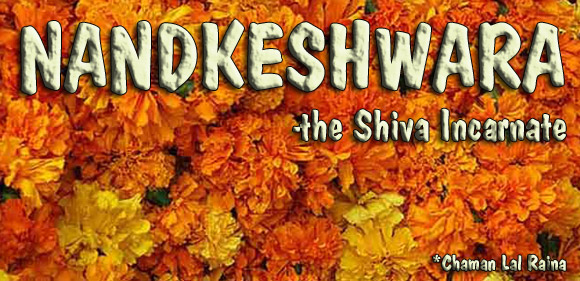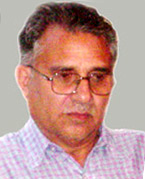NANDKESHWARA-the Shiva Incarnate
 |
 |
|
|
 Nandkeshwara is a symbol as well as a legend. As a symbol, it suggests the glory of Shiva, mounted on the Nandi and in the mood of a dialogue with Parvati. The abode of Shiva is Mount Kailasa. Numberless attendants known as Gana/ battalions have been assigned to look after the universe under the direct control of Nandakeshwara. He is the Guardian commander of the forces with different fiercing forceful looks, restless to obey the signals of the Master. The atmosphere around is quite serene with the Ashutosha nature of Shiva and law enforcing nature of Parvati. Enough to eat, the Himalayan snow to enjoy, nothing worth the name of scarcity, peaks filled with the aura of meditating Rishis and Munis, Yakshas and Kinnaras singing everywhere the glory of 'Shiva consciosness' . One is happy with the recitation of Rudra Mantra, the other is making the analysis of the Shiva Kavacham, next to them is putting the oblations with Bahu roop- garbha in the Agni-kunda and some are repeating the Maha Mritunjaya Mantra. But the realized souls are meditating upon Om Namah Shivaya Mantra. Parvati is enjoying the Maya/ play of her own creation, which is noticed by none except by Shiva himself. Shiva is Pinakina. Shiva is Shankara, Maheshwara, Bhava and with one Thousand Names, known as Shiva Sahsra -nama. All such names are his attributes given by the Rishis, because they are meditating upon him, other wise Shiva is transcendent in nature. Why so? "Shiva in Nishkala", so says the Veda. Shiva is Absolute in nature. Shiva is Prakash/Light. Shiva is Truth-Consciousness-bliss. Shiva is Sakala, with the glory of being Pashu-Pati /the Lord of creation. That is what the Shaiva Agamas explain to make the Shiva-consciousness touch the human understanding. Nandkeshwara is a symbol as well as a legend. As a symbol, it suggests the glory of Shiva, mounted on the Nandi and in the mood of a dialogue with Parvati. The abode of Shiva is Mount Kailasa. Numberless attendants known as Gana/ battalions have been assigned to look after the universe under the direct control of Nandakeshwara. He is the Guardian commander of the forces with different fiercing forceful looks, restless to obey the signals of the Master. The atmosphere around is quite serene with the Ashutosha nature of Shiva and law enforcing nature of Parvati. Enough to eat, the Himalayan snow to enjoy, nothing worth the name of scarcity, peaks filled with the aura of meditating Rishis and Munis, Yakshas and Kinnaras singing everywhere the glory of 'Shiva consciosness' . One is happy with the recitation of Rudra Mantra, the other is making the analysis of the Shiva Kavacham, next to them is putting the oblations with Bahu roop- garbha in the Agni-kunda and some are repeating the Maha Mritunjaya Mantra. But the realized souls are meditating upon Om Namah Shivaya Mantra. Parvati is enjoying the Maya/ play of her own creation, which is noticed by none except by Shiva himself. Shiva is Pinakina. Shiva is Shankara, Maheshwara, Bhava and with one Thousand Names, known as Shiva Sahsra -nama. All such names are his attributes given by the Rishis, because they are meditating upon him, other wise Shiva is transcendent in nature. Why so? "Shiva in Nishkala", so says the Veda. Shiva is Absolute in nature. Shiva is Prakash/Light. Shiva is Truth-Consciousness-bliss. Shiva is Sakala, with the glory of being Pashu-Pati /the Lord of creation. That is what the Shaiva Agamas explain to make the Shiva-consciousness touch the human understanding.The great source of knowledge to understand the Benign nature of Shiva is the Rudrayamala Tantra. Bhavani –Sahsranama is one of the chapters of this great treatise. It is the treasure of hope, heart’s love and the spiritual awareness in understanding what Shiva – Shakti is. Shiva is ‘Kevaloham / Alone I AM’, when he is in the Yoga Mudara. That is the state of ‘Soham/ I am That’ for Shakti. But what about for human beings? Nanadakeshvara is the answer. Who is Nandkheshwara? The legend runs as: Indra-Koot is a village in the Sumbal area of Kashmir. A very pious couple lived there. They were the followers of Shiva- Amreshwara – Amarnath. The family belonged to the lineage of Swamin Gautama. After great penances, they bore a male baby. Their spiritual Guru, who came to bless the child visualized through his intuitive faculty that the new born baby is graced with the divine attributes, but is destined to live only for a few years. The Guru did not reveal that heart piercing happening to them. Time passed on, the baby grew up as a very promising child and would go on the banks of the river Vitasta to offer water on the Shiva –lingam and be absorbed in the deep meditation. One day prior to the fateful happening, when this child would have been taken by Mahakala in his dark lap, the Guru invited this small child in his hermitage and instructed him accordingly: "O my Yogi child! You meditate upon the Maha-Mritunjaya-Mantra. You need to reach Mansarovar (Manasbal lake) at early dawn and step into the celestial queue, and follow Indra – the Guardian ruler of the Devatas." The Yogi child could not be noticed, as being very small and insignificant in the eyes of the Devatas. That day happened to be the Jyeshta Amavasya, on the Kritika Nakshatra. The little ascetic child did as instructed. All the Devatas were applied Tilaka-Gandham on the forehead by Brahma, blessing them with the Vedic Mantra—JIVETA SHARDA SHATAM /may you live the time duration of One hundred celestial years. In the queue was the little Yogi child, who too was blessed with the same life giving Mantra by applying the Tilaka- Gandham on his forehead .Brahma did not do it consciously, but he simply performed his Divine assignment. That very moment, he recognized his blunder. Devatas got startled, panic grew every where in the universe…,O what would happen with the Divine principle of creation, as the Lord of Creation himself fell in error. Vishnu with Lakshmi, and Shiva with Parvati were witnessing that complex situation. A divine confusion was seen on the immortal faces caused by the mere slip of tongue. All realized the efficacy of Mantra, because Mantra is the Shabda- Brahman/Powerful sound, transcending time and place. A congregation of the Devatas to be presided over by Shiva with Ashutosh attribute was announced. What happened then was not a miracle, or a cosmic change but only a reflection of the Grace of Parvati, as she is the Mother Creatrix par–excellence. She is the only source of power to transform death into immortality and to justify ‘Mrityor ma Amritamgamay’. After great deliberations, it was concluded that the child transformed into Immortality be adopted by Shri Parvati and to function as the Chief attendant of Parmsehwara Shiva He was assigned to work as the Nandi Rudra- commander of the forces of Shiva. The proposal was moved by Parvati and given the assent by Narayana. It was proclaimed by Brahma that the Immortal child will henceforth be addressed as Nandakeshwara. His color turned red, assumed four arms and three eyes. Saraswati sang the hymn:
"NANDI CHATUR BHUJAH RAKHTA CHATUR VAKTRA TRILOCHANA The translation runs as: "We pay our obeisance to Nandakeshwara, who is the Nandi with four arms, graced with having the three eyes and handsome face. He is the remover of obstacles. He is the dear son of Shri Parvati and the obedient worshipper of the Parmeshwara. He is the savior of the devotees," "NANDI RUDRAYA NAMAH, KANDI RUDRAYA NAMAH, This Bija/seed-syllable is the combination of six layers of consciousness around ‘Rudra’. It is the formidable nature of Shiva. Shiva is all auspiciousness and beauty.
1. Nandi Rudraya Namah: My obeisance be to Nandi Rudra! Nandakeshwara in his first Bijakshara is adored as Nandi Rudra. Nandi is Ajanma/eternal, because of being Absolute. Nandi assumed the human form in the Adi-Kalpa. The state of Ananda, which a devotee experiences is known as the Nandi state of mind. It is the identification of Samprajnyata Samadhi in a Shiva Yogi.
It is an integrated view of Mono syllable OM, with Fifteen Matras, Four half Matras, Two Anuswars and One Visarga. OM is the Absolute Primal sound. The essence of the Vedas is hidden in this Mono-syllable. It is the Brahman of the Upanishads. The Fifteen Mantras is the Fifteen syllabled Shri Maha Ragnya Dhyana Mantra. Two Anuswars are filled with the strength of Solar and Lunar energy and one Visarga is the merger of human spirit with Divine Self. "May we meditate upon Bija traya/ the Triple seed of consciousness! May we be conserving our energy with the Primordial Existence! May we be bestowed with the Shakti!" The Triple seed of consciousness is the Shiva-Shakti –Nandakeshwara. The Primordial Energy is Para Shakti Bhavani. She is Maharagnya, whose abode is at Tullamulla, close to Sumbal-the abode of Nandikeshvara. |
|
|
|
|
|
|
|
|
| Copyrights © 2007 Shehjar online and KashmirGroup.com. Any content, including but not limited to text, software, music, sound, photographs, video, graphics or other material contained may not be modified, copied, reproduced, republished, uploaded, posted, or distributed in any form or context without written permission. Terms & Conditions. |



 *Dr. Chaman Lal Raina did Masters in Hindi & English. Ph.D. in Hindi & Iqbaliat at the University of Kashmir. Worked on the research project at the Iqbal Institute for writing monographs on Indology as Research Associate. Worked as lecturer to teach research methodology in Iqbal Institute, University of Kashmir. Dr. Raina's first love is for the Vedas and the Shakti Tradition of India. To his credit goes some ten books on Indology. He was awarded Nagmani Fellowship, Buddhist Fellowship etc. from various Institutions. Presently Dr. Raina is associated with the Yoga Studies, religion and sanskrit at Florida International University, USA.
*Dr. Chaman Lal Raina did Masters in Hindi & English. Ph.D. in Hindi & Iqbaliat at the University of Kashmir. Worked on the research project at the Iqbal Institute for writing monographs on Indology as Research Associate. Worked as lecturer to teach research methodology in Iqbal Institute, University of Kashmir. Dr. Raina's first love is for the Vedas and the Shakti Tradition of India. To his credit goes some ten books on Indology. He was awarded Nagmani Fellowship, Buddhist Fellowship etc. from various Institutions. Presently Dr. Raina is associated with the Yoga Studies, religion and sanskrit at Florida International University, USA.